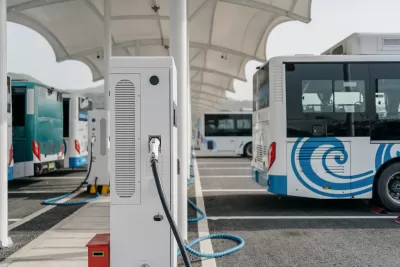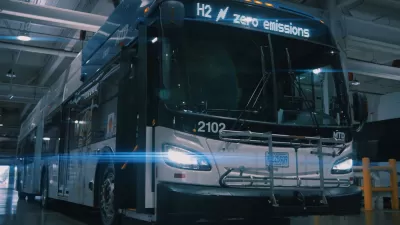Two programs designed to help transit agencies shift to electric and zero-emission fleets contain rules that could slow the adoption of zero-emission vehicles.

An analysis by Transportation for America finds that certain provisions of the federal Low or No Emission Vehicle (Low No) and Bus and Bus Facilities programs limit their effectiveness and “artificially constraining the supply of zero-emission funds, locking in unnecessary transit emissions for decades.”
Based on information obtained by T4A through a Freedom of Information Act (FOIA) request, T4A concludes that “the [Low No] program encourages transit agencies to buy diesel hybrid and compressed natural gas (CNG) buses instead of zero-emission buses running on electricity or hydrogen,” with 25 percent of the Low No program’s funding aimed at low-emission, not zero-emission, vehicles and projects.
While “The Bus and Bus Facilities program does not place constraints on fuel types when considering awards,” T4A found that “zero-emission projects had a one in six chance of being awarded while consuming 83 percent of the program’s available funding.”
According to T4A, “Congress can do more to ensure that these programs are working to accomplish emission reduction goals” by increasing funding for both programs to meet the overall demand for buses and facilities; creating incentives for both programs to leverage other funding sources; and increasing transparency of the program by making basic application and award information available on FTA’s website and looking for ways to simplify the application process.”
FULL STORY: Greener Fleets: How federal dollars can supply the demand for clean transit

Alabama: Trump Terminates Settlements for Black Communities Harmed By Raw Sewage
Trump deemed the landmark civil rights agreement “illegal DEI and environmental justice policy.”

Planetizen Federal Action Tracker
A weekly monitor of how Trump’s orders and actions are impacting planners and planning in America.

The 120 Year Old Tiny Home Villages That Sheltered San Francisco’s Earthquake Refugees
More than a century ago, San Francisco mobilized to house thousands of residents displaced by the 1906 earthquake. Could their strategy offer a model for the present?

BLM To Rescind Public Lands Rule
The change will downgrade conservation, once again putting federal land at risk for mining and other extractive uses.

Indy Neighborhood Group Builds Temporary Multi-Use Path
Community members, aided in part by funding from the city, repurposed a vehicle lane to create a protected bike and pedestrian path for the summer season.

Congestion Pricing Drops Holland Tunnel Delays by 65 Percent
New York City’s contentious tolling program has yielded improved traffic and roughly $100 million in revenue for the MTA.
Urban Design for Planners 1: Software Tools
This six-course series explores essential urban design concepts using open source software and equips planners with the tools they need to participate fully in the urban design process.
Planning for Universal Design
Learn the tools for implementing Universal Design in planning regulations.
Clanton & Associates, Inc.
Jessamine County Fiscal Court
Institute for Housing and Urban Development Studies (IHS)
City of Grandview
Harvard GSD Executive Education
Toledo-Lucas County Plan Commissions
Salt Lake City
NYU Wagner Graduate School of Public Service





























